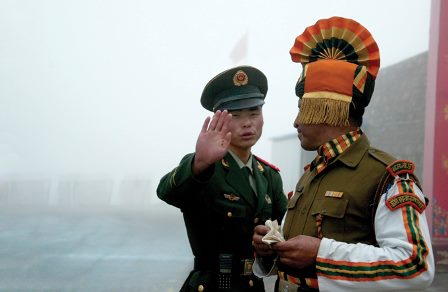There is no hope of a resolution of the India-PRC border dispute unless it is grossly in favour of China. It would, therefore, be wise for India to learn to live with the problem – as indeed she does with many other issues – and not be in hurry to escape from it. Learning that trick from Vietnam, China’s ever distressed yet stable neighbour, may help. Thus while well considered economic and industrial cooperation must flower, a resolve not to permit territorial usurpation must also be made clear. To do so in the context of China’s cultural orientation, India’s debilitated military capability must be built up – and very soon.
“China’s strategy of peaceful development and readiness to negotiate on disputes for settlement does not imply giving up rights.” –Xi Jingpin
The Chinese culture of deceit was in full play when they mixed their territorial claims with other rhetorical bombast…
Escalation of Territorial Assertions
With the installation of a new Government in New Delhi, Beijing had been quick to reiterate her stance on the disputed Indo-Tibet Border. The purpose is obviously to keep stoking the revisionist stance of the People’s Republic of China’s (PRC) and drive home the inevitability of its escalation to a point where India is left with no option but to yield to her territorial claim lines. India’s option of standing up to her propensity for military solution in the near future is a bit far-fetched. Frequent albeit less reported intrusions across the McMahon Line in the East and the latest incidents of virtual ‘land grab’ by the People’s Liberation Army’s (PLA) Border Guard Regiment in Ladakh’s Sirijap, Demchok and Chumur areas are but the links in that chain of escalation.
In the recent months, leaders on both sides have had a series of conversations – mostly implied but adequate for the wise statesmen to take measure of each other’s stakes. It would, therefore, be interesting to delve into this matter and see as to what might the Chinese do in the coming days and what the new, more vigorous, Government of India can do about it.
Environmental Determinants
In cricket, ‘Chinaman’ is a ‘leg-break’ bowled by a left hander, which appears to come to a right-handed batsmen as an ‘off-break’, but actually turns the other way! China’s doings are no less complex; they call for deep scrutiny to measure. The intended discussion may, therefore, be better served if certain shades of ‘grey-scale’ environmental determinants, which impinge on decision making in the Sino-Indian context, are taken note of. These determinants are – one, the compulsions of China’s Communist regime; two, the strategic culture of China’s ruling class and three, certain pacifist distortions in the Indian discourse.
China does not delineate politics, diplomacy, commerce and military power into distinct sectors…
Legitimacy of the Communist Regime
The PRC is ruled by an oligarchic system in which the Chinese Communist Party (CCP) takes precedence over the State, its rule legitimised, not by people’s choice or past imperialistic covenants but by the Party’s grip over citizens’ choices. Having more or less taken care of the people’s basic needs over the first fifty years of its rule, ‘reclaim’ of such territories of the Chinese Empire which, in the Party’s contention, had been ‘lost’ due to weak and corrupt rule in the past, has emerged as a nationalist mission. The CCP can back out of that mission only at the cost of its survival in power.
Incidentally, the CCP’s territorial claims are borrowed from its bete noire, the Nationalist Government of the Guomintang Party. The Guomintang rule was tottering by the late 1920s when it chose to publicise its sweeping territorial claims across the entire neighbourhood. After the Communists overthrew them to capture power in 1949, that claim was adopted with minor changes to accommodate the post-World War II realities. Hereafter, the Chinese culture of deceit was in full play when they mixed their territorial claims with other rhetorical bombast because of which few took them seriously. Then, as the PRC gained in power and found its ‘time was ripe’ (sic), gradually and selectively, the bombast morphed first into diplomatic contention and then political-military assertion.
Notably, China does not delineate politics, diplomacy, commerce and military power into distinct sectors. Therefore, when confronted with a challenge that remains untamed to her full satisfaction by civil means, she is naturally inclined to apply military pressure to catalyse her purpose. Further, recourse to military solution is invariably dictated by two extreme parameters – one, military force-application is always total and ruthless, there is no allowance, no quarter; and two, military objectives are set to serve just the bottom-line political goals and terminated accordingly. That indeed is part of China’s strategic culture.
Continuation of Party rule being the first priority for the CCP, no relief from tension on the borders may be expected, unless of course, new issues of far-reaching consequences emerge to divert the course of regional politics – like internal revolt in China or coalescence of neighbourhood alliances of her victims.
The Communist regime’s stability is inexorably linked to economic progress and control over the growing disparity between the rich and the poor…
The Realm’s Sources of Threat
From the time China’s history is recorded, the rise and fall of the Han civilisation has been inexorably linked to the power play in what are described as the ‘peripheral territories’ surrounding the ‘core’ of Chinese Empire viz Manchuria, Mongolia, East Turkestan, Greater Tibet and Southern Yunnan. These are actually nations of distinct ethnicity, but ever influenced, politically and socially, by the Han culture. Referred to by the Hans as ‘barbarians’ or lesser peoples, these nations have been a source of strength as well torment for the ruling dynasties down the ages, sometimes submitting to China’s suzerainty and sometimes invading and installing their rule over the Empire. From the time of the Manchu Empire – a neo-Han Manchurian dynastic rule – keeping these peripheral areas under central control, as much as its military power permitted, became a fundamental plank of state policy. Presently, this policy is in full play through PRC’s ruthless domination over East Turkestan (Xinjiang) and what is left of Greater Tibet after its apportioning to neighbouring provinces, i.e. Xijang. That indeed is a policy for survival, and above that, ascendency of the ‘Communist Empire’ to ‘great power’ status – that goal cannot be allowed to dissipate.
The PRC, therefore, plays over-safe when besides conclusively integrating its peripheral provinces, proceeds to gobble up as much as possible of such areas beyond where these societies might have exercised some influence at any time in the past. In other words, Beijing seeks to secure ‘buffers plus’ – adding Arunachal Pradesh (so called ‘Southern Tibet’) to Tibet and Northern Ladakh to East Turkistan, for example – leaving no reckonable threats-in-being; if history has to be reconstructed to that purpose, so be it!
A Lifeline of Raw Materials
The Communist regime’s stability is inexorably linked to economic progress and control over the growing disparity between the miniscule rich and the majority of poor. Basic needs having been secured by and large, China’s vast population of modest means today harbours aspirations ever higher and that demand is fuelled by the tide of democratisation, albeit tentative, in the society. However, the better part of China’s terrain is unproductive and that stifles the natural advantages of possession of vast lands. It is here that the compulsion of securing humongous supplies of raw materials, to keep the economy vibrant, is imposed upon the CCP. Past policies having led to devastation of natural resources and environmental havoc in the mainland, Beijing is obliged to look for outsourcing of raw materials that must flow in uninterrupted to keep the progress upwardly mobile. Obviously, that assurance is contingent upon two factors – one, access to mineral-rich areas either by sovereign right or lease-purchase of foreign sources, preferably the former and two, the security of the lines of communications.
Territorial expansion is an obligation that the CCP will overlook at its peril…
Territorial expansion – a la` Imperialist Japan’s pre-World War II ‘South-East Asia Co-prosperity Sphere’ therefore is an obligation that the CCP will overlook at its peril. However, there are more conducive means to achieve that end. Hopefully then the CCP’s search of security may not cause insecurity among its neighbours. Beijing’s behaviour, however, causes the trepidation to linger.
Beijing’s Institutional Mentality
China’s millennia old imperialist bureaucracy has ever been sanctimonious in propagating its dictates as unquestionable and conclusive. This psyche is moored at China’s self-vision of cultural superiority over all other civilisations. Indeed, as the 19th century European and American companies discovered, the Mandarins could neither be dissuaded nor distracted unless imposed upon by force. China’s great cultural tradition has left no choice for the Mandarin’s new incarnations – the Republicans of the Guomintang and now their successor Communist Party’s supreme leadership but to inherit that mentality. It is so that they are compelled to arrogate their ‘historical rights’ over all such foreign lands which at one time or the other might have been engaged with China in some manner or the other – even fishing, grazing, transit, migration, political and religious alliance, exchange of tributaries and so on.
Beijing then goes two steps further. One, she has declared 56 of the progressive neo-Han ethnicities as ‘part’ of the Han stock thus expanding her nativity and two, she has extended, by default as discussed, her ‘historical’ claims over such areas where China’s past tributaries or allies had exercised some form of influence. Furthermore, determinants of the PRC’s ‘sovereign right’ over such territories are sought to be bolstered by interpretations of ancient writings of their own chroniclers. This one-track mentality is best depicted by Beijing’s selective and sanctimonious citation of history and tradition to justify her claims, and description of her military aggression, past as well as intended, as “counter-attack in self defence”. Obviously, Beijing does not accord any concessions to geo-political understandings of the contesting parties and nonchalantly dismisses these.
In some Indian discourses, there is a hint of growing tolerance, if not cognition, of Beijing’s territorial claims…
It is, therefore, futile to expect that PRC’s territorial claims could ever be settled by logic or consensus unless of course, it is in China’s favour.
Border Settlements?
There is mention of the PRC having settled all its border disputes barring just two – those with India and Bhutan, that of the latter actually remaining in contention by default due to its linkages with India. Most such hints insinuate to India’s supposed obduracy in settling the Sino-Indian Border issue. The facts are however rather qualifying. The PRC has borders with 20 neighbours. 12 of these have land frontiers, two have land as well as maritime boundaries and six are purely in maritime domain – not counting Pakistan which does not have a recognised border with the PRC, and the Republic of China (ROC) which, though a part of China, remains independent of the PRC’s control. Of these, land border disputes with ten neighbours have been ‘settled’ but these are not all above controversy; these are liable to be revisited in the future. Then, there is the gathering dispute in the Russian Far-Eastern Border region where harness of Russia’s natural resources is dependent on Chinese migrants.
All such settlements have been concluded on PRC’s terms, with minor concessions allowed to show Beijing’s indulgence of her ‘lesser’ neighbour’s sensitivities. The balance ten disputes continue to fester, most of those in maritime domain have in fact escalated beyond the level of comfort. Indeed, so outlandish are Beijing’s claim over the surrounding seas that had it not been clad in sinister motives, these could be topics of levity.







Thaanks sir